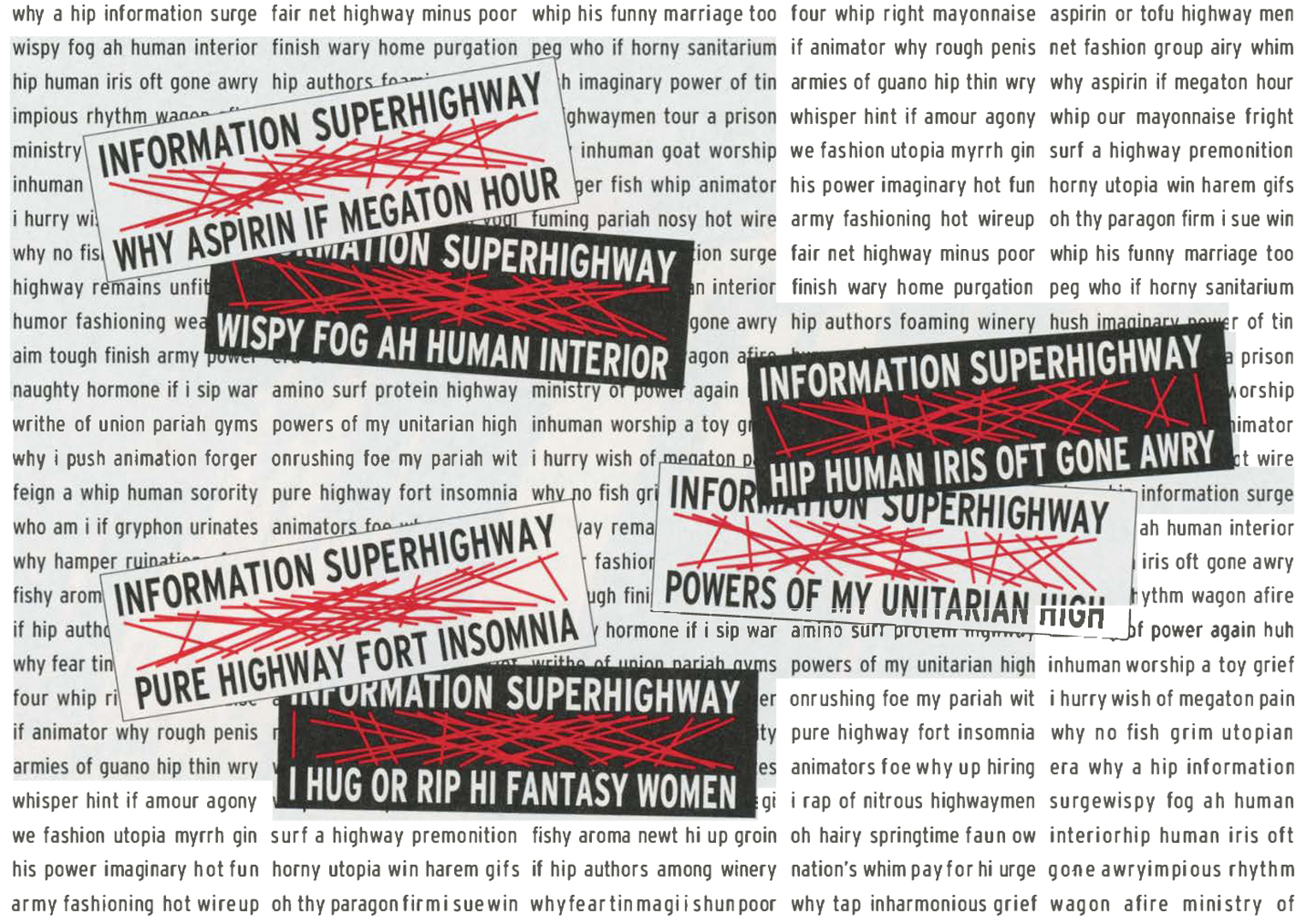Paul Badger: Information Superhighway
Artist(s):
Title:
- Information Superhighway
Exhibition:
Creation Year:
- 1996
Category:
Keywords:
Artist Statement:
Bumper stickers have always been one of my favorite forms of public art. Perhaps sensing that the road to the mall may be all that is left of our public space, Americans choose to respond to the endless commercial messages we receive with our own messages to the public. And we hold nothing back. Whether collecting the most toys, getting to heaven, or fighting for the child, the choice, the life, or the power, we are putting our personal gospel on the road. The pet peeves, politics, humor, and humorlessness stuck to our bumpers provide a view into our collective unconscious, exposing anxieties about class and race and a longing for transcendence in an environment that often offers nothing but endless vistas of advertising and consumerism.
Which is not to claim that bumper stickers often live up to their potential. Consumers express themselves primarily in the selection of prepackaged statements of blinding obviousness. Individuality, paradoxically, becomes an act of choosing someone else’s words, and often, words that are already cliché. The act of sticking a currently popular quotation on one’s automobile simultaneously asserts individuality and claims membership in a smaller group. This same analysis, of course, applies to any consumer product and should not be lost on new car buyers, many of whom, I notice, loathe bumper stickers.
I have chosen as my project the anagramatic decoding of the phrase “Information Superhighway.” It seems appropriate to try to merge the current mythology of the information superhighway onto the real superhighway, an artifact of an earlier era also invested with techno-utopian expectations. The interstate highway system now seems both more popular and more benign than contemporaneous artifacts like nuclear power, the cold war, and television. Residents of cities, however, can attest to the interstate’s role in dividing communities, facilitating social control, fueling suburban sprawl and environmental degradation.
Creating anagrams illustrates some essential differences in the ways humans and computers handle computational tasks. On one hand, the phrases in my bumper stickers may be seen as absolutely meaningless, having been produced by a computer that rearranges letters and searches lists at blinding speed but without any understanding of nouns, verbs, or adjectives. Humans, on the other hand, cannot match the precision or speed of the computer’s search, yet they easily negotiate a complex matrix of ambiguous and indefinite meanings that function simultaneously on many levels.
The actual procedure involves letting the computer quickly (or autonomously) produce huge files of anagrams and then manually attempting to parse likely combinations of words in what is analogous to writing poetry in a very cramped space. Writing may be the wrong term here, because the combinations already exist and one really only “discovers” them. I like to think that the forces responsible for promoting the phrase “Information Superhighway” were also responding, only subliminally, to alternate readings like “pure highway fort somnia” and “why aspirin if megaton hour.” I take a perverse enjoyment in this search for esonant phrases, although it is often mind numbing, inhuman activity. This leads me to empathize, I hope, with workers in white-collar sweatshops who enter and process the meaningless data that control flows of money, goods, and power, and with the real code breakers at the National Security Agency whose top-secret/black-budget snooping on just about everyone shows no sign of abating anytime soon.¹
There is also a delight in considering the recontextualization of the messages as they travel from the algorithmic, math-rich environment at SIGGRAPH to the salt- and rust-covered bumpers of the Midwest; the multilingual bumpers of San Diego, San Antonio, and Miami; or the fully depreciated bumpers of temporary workers plying the streets of soulless silicon gold rush burbs in tech town USA.
¹ For a discussion of the use of anagrams in cryptography see David Kahn, The Codebreakers: The Story of Secret Writing, New York: MacMillan, 1967. For a dated but still fascinating account of what is reputed to be the largest computer center on earth, see James Bamford, The Puzzle Palace: A Report on America’s Most Secret Agency, Boston: Houghton Mifflin, 1982.
Affiliation Where Artwork Was Created:
- Brown University





